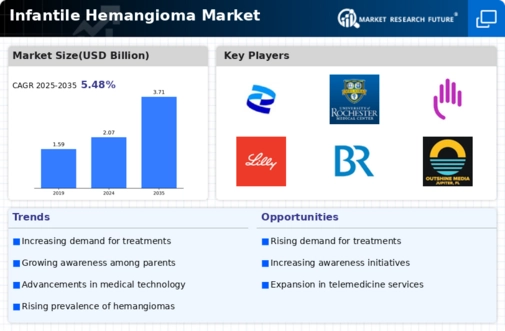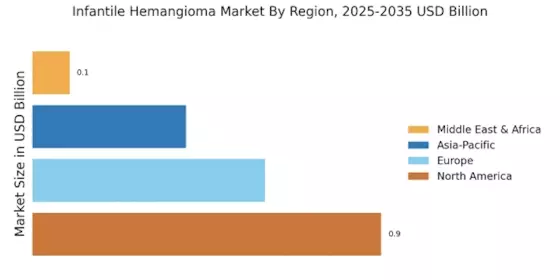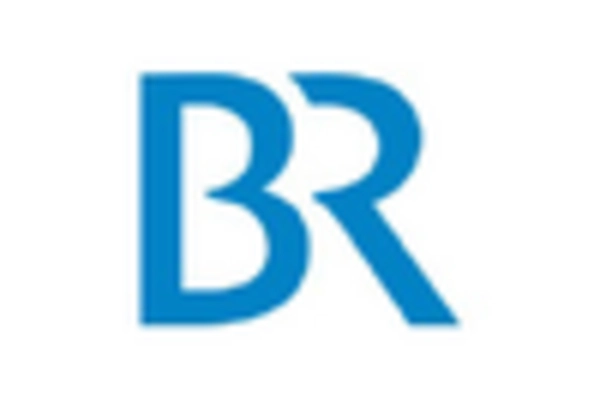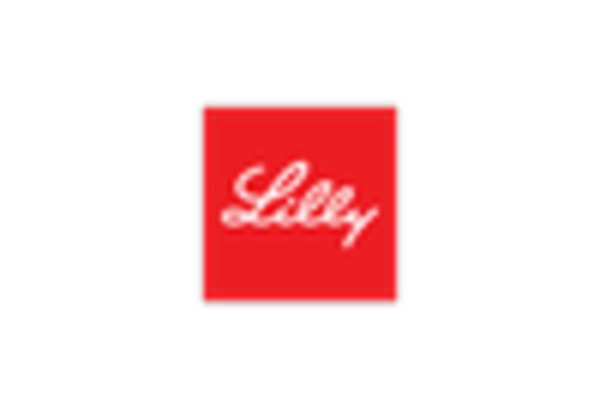Rising Parental Awareness and Advocacy
Rising parental awareness and advocacy play a pivotal role in shaping the Infantile Hemangioma Market. As parents become more informed about infantile hemangiomas, they are more likely to seek timely medical intervention for their children. This heightened awareness is often fueled by online resources, support groups, and advocacy organizations that provide valuable information about the condition. Consequently, increased parental engagement can lead to earlier diagnosis and treatment, which may positively impact patient outcomes. The demand for effective therapies is likely to rise as parents advocate for better healthcare options for their children. Thus, the Infantile Hemangioma Market is expected to benefit from this trend as it aligns with the growing emphasis on patient-centered care.
Growing Investment in Pediatric Healthcare
Growing investment in pediatric healthcare is a critical driver for the Infantile Hemangioma Market. Governments and private entities are increasingly recognizing the importance of addressing pediatric health issues, leading to enhanced funding for research and treatment initiatives. This investment is likely to facilitate the development of new therapies and improve access to existing treatments for infantile hemangiomas. Furthermore, as healthcare systems prioritize pediatric care, the availability of specialized services is expected to increase, thereby benefiting affected infants and their families. The focus on pediatric healthcare is anticipated to bolster the Infantile Hemangioma Market, as stakeholders strive to meet the evolving needs of this demographic.
Increasing Incidence of Infantile Hemangiomas
The rising incidence of infantile hemangiomas is a notable driver in the Infantile Hemangioma Market. Recent studies indicate that these vascular tumors occur in approximately 4 to 5% of infants, with a higher prevalence in females. This increasing occurrence necessitates enhanced awareness and treatment options, thereby propelling market growth. As healthcare providers recognize the need for effective management strategies, the demand for innovative therapies is likely to rise. Furthermore, the growing number of pediatric patients requiring intervention may lead to an expansion of healthcare services focused on this condition. Consequently, the Infantile Hemangioma Market is poised for growth as stakeholders seek to address the needs of this patient population.
Collaborative Efforts in Research and Development
Collaborative efforts in research and development are emerging as a significant driver in the Infantile Hemangioma Market. Partnerships between academic institutions, healthcare providers, and pharmaceutical companies are fostering innovation in treatment approaches. These collaborations aim to enhance understanding of the pathophysiology of infantile hemangiomas and to develop targeted therapies. By pooling resources and expertise, stakeholders can accelerate the discovery of new treatment options and improve existing ones. This collaborative spirit is likely to lead to breakthroughs that could transform the management of infantile hemangiomas. As a result, the Infantile Hemangioma Market is expected to experience growth, driven by the collective efforts of various entities committed to advancing care for affected infants.
Technological Advancements in Treatment Modalities
Technological advancements in treatment modalities are significantly influencing the Infantile Hemangioma Market. The introduction of novel therapies, such as propranolol and laser treatments, has transformed the management of infantile hemangiomas. Propranolol, a beta-blocker, has emerged as a first-line treatment, demonstrating efficacy in reducing the size of hemangiomas. Additionally, advancements in laser technology have provided non-invasive options for patients, enhancing treatment outcomes. The market is witnessing a surge in research and development efforts aimed at optimizing these therapies, which could lead to improved patient experiences and outcomes. As a result, the Infantile Hemangioma Market is likely to expand, driven by the demand for effective and innovative treatment solutions.


















Leave a Comment